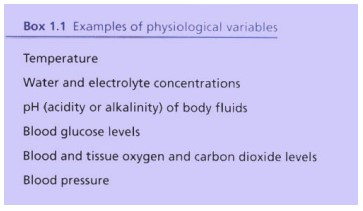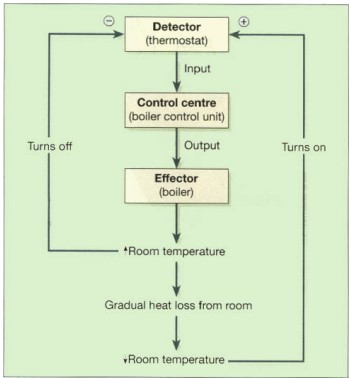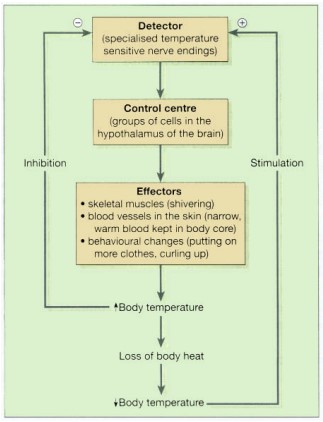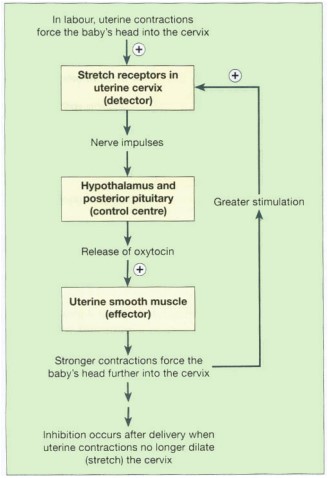What is homeostasis?
The composition of the internal environment is maintained within narrow limits, and this fairly constant state is called homeostasis.
Literally, this term means ‘unchanging’, but in practice, it describes a dynamic, ever-changing situation kept within narrow limits. When this balance is threatened or lost, there is a serious risk to the well-being of the individual. There are many factors in the internal environment that must be maintained within narrow limits and some of these are listed below.

Control mechanisms that recognize and react to alterations in the internal environment preserve homeostasis. The detector, control center, and effector are the three fundamental parts of a control system, as shown below. The control center chooses the parameters that should be maintained for the variable factor. It takes a signal from the detector or sensor and incorporates the data that comes in. The control center reacts and modifies its output to the effector when the incoming signal indicates that a change is required. This dynamic process keeps equilibrium in place.

room temperature by a domestic boiler.
Negative feedback mechanisms
The effector response lessens or cancels out the effects of the initial stimulus in systems governed by negative feedback, thereby reestablishing homeostasis (thus the term negative feedback). The regulation of body temperature is comparable to the non-physiological example of a central heating system in a home. Changes in the ambient temperature can be detected by the thermostat (temperature detector) (variable factor). The boiler control unit (control center), which regulates the boiler, is connected to the thermostat (effector). The thermostat continuously compares the data from the detector with the preset temperature and makes modifications to the thermostat setting to change the room’s temperature as needed. The boiler control unit is turned on when the thermostat determines that the room temperature is too low.
The boiler produces heat as a result, warming the space. The system reverses when the predetermined temperature is attained. The boiler control unit receives input from the thermostat, which turns the boiler off after detecting the increased room temperature. The boiler’s output of heat ceases, and as heat is lost, the room begins to gradually cool. This chain of events, which functions as a negative feedback loop, allows for ongoing self-regulation or control of a variable factor within a specific range.
A physiological variable that is governed by negative feedback is body temperature, as seen in the image below. Specialized temperature-sensitive nerve endings detect when the body temperature drops below the predetermined level. The clusters of brain cells that make up the control center in the hypothalamus, convey this information as input. The control center’s output triggers systems that increase body temperature (effectors).

- Stimulation of skeletal muscles causing shivering
- Narrowing of the blood vessels in the skin reduces the blood flow, and heat loss from, the peripheries
- Behavioral changes, e.g. we put on more clothes or curl up.
When body temperature rises to within the normal range, the temperature-sensitive nerve endings no longer stimulate the cells of the control center and therefore the output of this center to the effectors ceases.
Positive feedback mechanisms
The body only contains a few numbers of these amplifiers or cascade systems. In positive feedback mechanisms, the stimulus gradually raises the response, causing the response to gradually rise as long as the stimulus is maintained. Blood clotting and uterine contractions during labour are two examples. Oxytocin, a hormone, stimulates uterine contractions during labour. These press the baby’s head onto the uterine cervix, triggering the region’s stretch receptors. This causes the production of additional oxytocin, which intensifies the contractions and keeps labour from ending. The release of oxytocin stops once the baby is born since the stimulus (stretching of the cervix) is no longer there, as indicated in the image below.

Also read: How to keep liver healthy